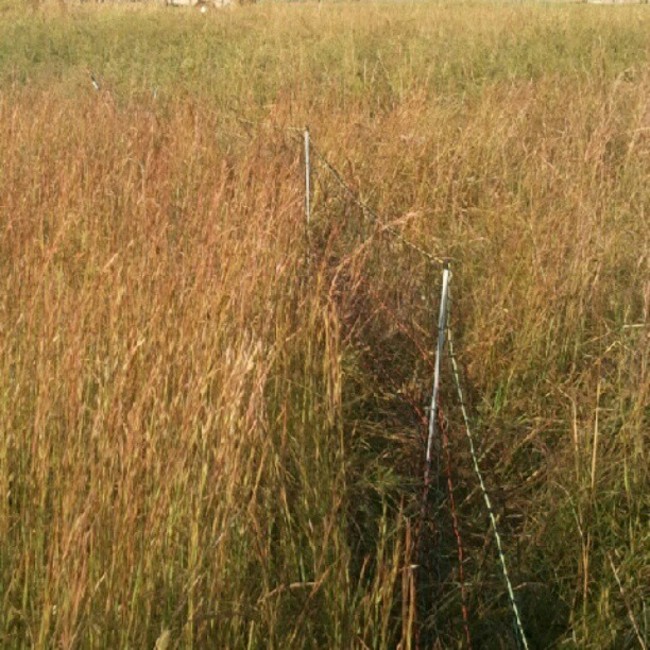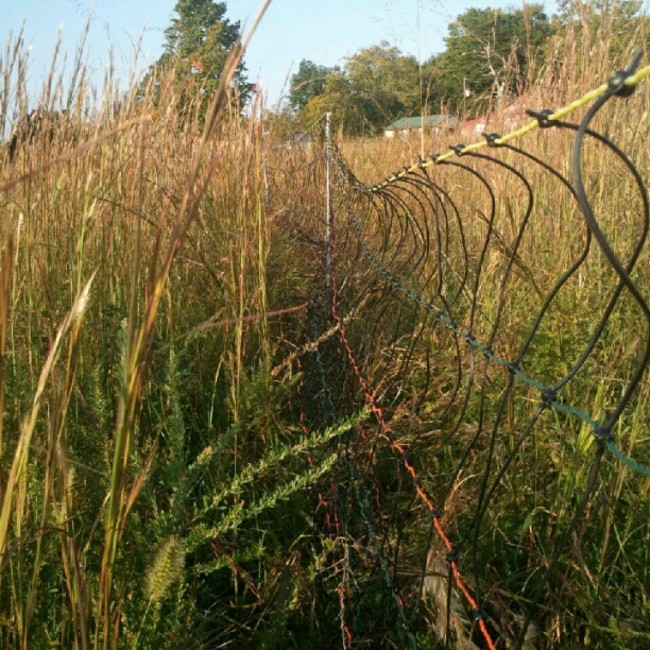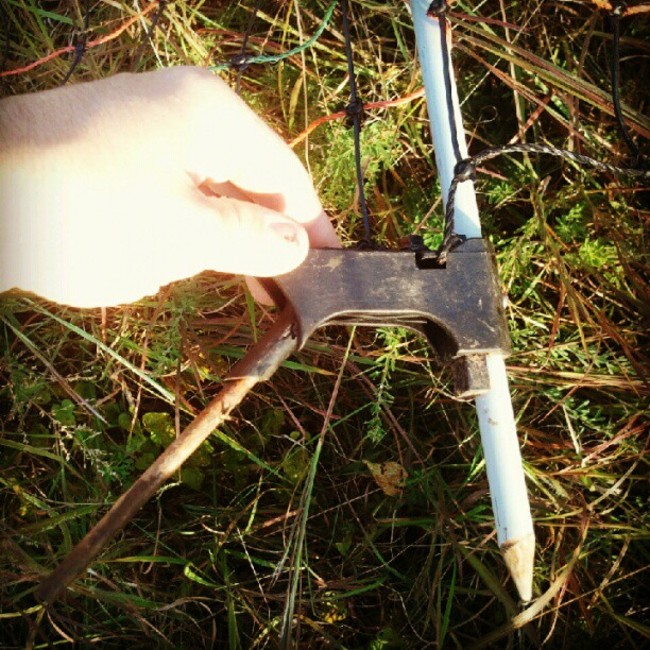Fencing is what I spend the most time doing (and thinking about) on the farm. That's probably why I bore our readers with posts about fencing so frequently. My time is split between so many different things that saying one thing dominates another is hard to do, but fencing is a clear standout. So saddle-up for another fencing thriller: Electro-Netting vs. Polywire.
Since we rotationally graze the goats fencing is a constant topic of interest. It seems like I change how we fence the goats every few weeks. If we just had a single grazing area, or even just a few grazing areas, it wouldn't be such a big deal. Put up some posts, put up some fence, and then you're done. That's how 99.9% of goat farmers do it, and I can see why. Moving the goats every 3-7 days is a chore and everyone knows that chores aren't fun. However, I don't mind it. In fact, I enjoy moving the goats.
Why? Because the goats love it, and happy goats are the whole point of what we're doing. Happy goats = happy Scrapple. At least once or twice per week I get to see the joy on the goat's faces as they enter the new paddock and run around scrambling to find the best spots with the best forage. Over the subsequent days they enjoy their feast and when it looks like they're just about done I move them to a brand new spot. It's the same joy a chef must have feeding his diners.
It's also more cost-effective (lower feed costs), better for the environment (forage recovery periods, nutrient cycling, reduced carbon emissions, etc), better for the health of the goats (grain destroys proper rumen function), and better for the consumer (milk from organic, pasture-based diets is nutritionally superior to grain-fed, confinement based diets).
 Using electro-netting through tall grass can be a pain, but it's the same pain as with polywire
Using electro-netting through tall grass can be a pain, but it's the same pain as with polywire
Electro-Netting
How do we do it?
Right now we're using electro-netting, which is what it sounds like: A ~3' tall electrified net that I can easily pick up and move around the farm to keep the goats confined to a specific area. I use 3 or 4 164' rolls to create a grazing paddock, depending on what forage is out there and how big I want the paddock to be. I can take down and set up a paddock in an hour or two. That equates to 50-150 hours per year. Not bad. Multiply fencing across the cows, pigs, bucks, the perimeter, etc and it adds up, which is why fencing tops the charts on my to-do list.
Previously, we were using polywire and step-in posts, which was fine for a few months, but ultimately became a disaster. It was way too much labor and it was incredibly frustrating. For the cows polywire makes sense since it's one strand. Four strands for goats is unstainable on a human level (for me).
Here's some pros and cons to electro-netting vs. polywire, in my opinion:
Pros of Electro-Netting:
1.) Easy to unroll, step-in, and move on. No need to re-trace your steps as with polywire (4 times for goats).
2.) It's a real barrier for anything getting in or out, not just a couple strands of wire, it's an electrified net that is not to be messed with.
3.) Easy storage and portability. Roll it up and pack it away. No reels, no posts, no gate handles. It's all one piece.
4.) Believe it or not, I have less tangles and less of a mess when I'm using the electro-netting. Maybe I'm just slow when it comes to using polywire and fence reels, but the polywire would always seem to jump off the reel and get tangled around the handle. Sweetbreads will testify that I don't understand how to untangle knots, so if I avoid them if I can.
Cons of Electro-Netting:
1.) See above photo. The metal stake-ends are useless. At first they seem cool, but then you try to step them into moderately hard ground and they bend and break. Right now almost every post is missing it's metal stake-end. At one point it actually made me happy when the darn things would break off, then I wouldn't have to mess with them. The good thing is that the faux-wood end works just fine, just be sure to step it into the ground well. I have yet to have the wood-end break.
2.) Animals that are not trained to the fence will get tangled in it until they learn not to mess with it. The goats will walk into it the first time you use it. Possibly more than once (erhm, Willow). Make sure you DON'T LEAVE THEM ALONE UNTIL YOU SEE THEM TEST THE FENCE. Once they test the fence and get tangled you can turn the fence off and let them out. They shouldn't mess with it again. ALTHOUGH YOU SHOULD WAIT AND SEE TO BE SURE. Willow probably got shocked 4 or 5 times before she learned. For the most part the goats witnessing the shocking will get the hint. Not all of them will test the fence. If you know your animals' personalities you'll know which ones will be the testers and which won't.
3.) Repairing the electro-netting is more difficult than repairing polywire. With polywire you just cut it and tie it back together. Kencove sends a kit to repair the netting, which is nice, but you still have to take the time to repair it, whereas polywire can just be tied back together on the spot. Also, if a post breaks on electro-netting you're in a bind, you can't just grab another one from the truck.
4.) Electro-netting grounds out more easily. You can't set the electro-net wires higher on the post like you can with polywire. That means it's almost guaranteed to be grounded out to some degree. The fence won't have the 'zap' that polywire will. However, CRAPPY FENCING CAN BE OFFSET BY GOOD FORAGE MANAGEMENT. If the goats are happy in the paddock they won't test the fence. We've only had goats jump the fence when we split up the herd. If they're all together and there's plenty of food inside the fence then they won't even bother jumping or trying to get out.
I'm sure there's plenty of pros and cons that I'm forgetting, but that about sums it up for what comes to mind. Your mileage may vary.
Anyone out there tried both techniques? Any preferences? Any alternatives that you like better?



